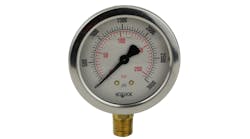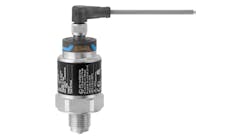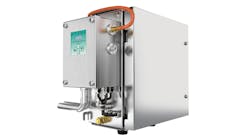Alas, like last year, we searched the product offerings (listed below), almost in vain. We found only one sensor with a fieldbus output, and three with HART outputs. Once again, not a single sensor has IEEE P1451.4 or uses MEMS in its construction. If they do, the vendors chose not to say so, which doesn’t make a bit of sense.
One new market study, Industrial Sensor Technologies and Markets, from Electronics Publications ($3,850, order from www.electronics.ca) continues the same fanciful prediction, saying that “strongest growth arises from the semiconductor industry and further integration of microelectromechanical systems, all of which are expected to grow at an average annual rate of 7.6%.”
That’s a very nice prediction, and in line with last year’s market studies. But one wonders: How are sales are going to grow that fast if nobody makes the sensors? Maybe all those fancy new sensors are appearing in automotive and semiconductor markets, but they certainly are not in the process control market.
We spotted two trends in this year’s offerings that the market researchers appear to have missed: Safety and stainless steel. We see two sensors addressing safety issues. We have sensors that conform to safety standards and practices, including NAMUR, SIL 2 and SIL 3, IEC Standard 61508/ISA S 84.01, IEC PED (Pressure Equipment Directive) category IV for mechanical integrity, and TÜV. Several other sensors are intrinsically safe, suitable for use in hazardous areas. We also found several sensors that use stainless steel in their construction, making them suitable for use in sanitary, abrasive and corrosive environments, and in clean-in-place applications.
Finding at least two sensors that are similar makes it a trend in our book, especially since that’s two more examples for a trend than all the market researchers have for their trends.
Product Roundup: Pressure Sensors
Pressure Transmitter has Fieldbus Output
The Barcon PPC pressure transmitter has a ceramic sensing face that resists corrosion and abrasive media, and can be ordered for sanitary applications with the 3A mark. It measures gases, vapors or liquids. Intrinsically safe models allow installation in explosive areas with certifications to CSA, FM and ATEX standards. Outputs include fieldbus protocols such as Profibus PA and HART. Pepperl+Fuchs; 330/486-0002; www.am.pepperl-fuchs.com
Safety First
The Model 268 2600T Safety Pressure Transmitter complies with SIL 2 and SIL 3, is certified to IEC Standard 61508/ISA S 84.01, meets IEC PED (Pressure Equipment Directive) category IV compliance for mechanical integrity, and has TÜV certification for defining a process plant’s SIL. The instrument has self-diagnostics for safety applications, signal validation of both sensor and the electronics, and hardware/software redundancy. ABB; 215/674-6580; www.abb.com
Updated Transmitter
Enhancements to the venerable LD301 smart pressure transmitter include improved turndown of 120:1 and NAMUR compatibility. It provides output current levels for failure and saturation conditions according to the NAMUR NE-43 specification, thus allowing for a standardized connection between 4–20 mA devices. Controllers based on the NAMUR specification can interpret the range saturation and sensor failure diagnostics and use it for interlocks in their control strategy. Smar; 713/849-2021; www.smar.com
Hazardous Sensor
Series 102M pressure sensors have been certified under ATEX and CSA as intrinsically safe for use in hazardous environments. The devices measure dynamic pressure events such as surges, pulsations, and spikes, making them suitable for monitoring the performance of compressors, pumps, and gas turbines, or to detect flow anomalies in piping systems. The sensors have a low-impedance signal that may be transmitted over long cable distances. PCB Piezotronics; 888/684-0011; www.pcb.com
Sanitary Transmitter
The model 4500 sanitary pressure transmitter has 3-A and EHEDG approvals and provides a smooth, crevice-free housing design with high-quality electropolished wetted-surface finishes. It works in steam-in-place and clean-in-place applications, making it suitable for life-science applications. HART communications allows for increased diagnostic capabilities, faster calibrations and configuration changes. It works with the company’s AMS package for FDA compliance and audits. Emerson Rosemount; 800/999-9307; www.rosemount.com
Hazardous Pressure Transmitters
PT-L1 pressure transmitters are approved for use in hazardous locations. An intrinsically safe model is available for Class I, Div. I, Groups A, B, C and D, and an explosion-proof model is available for Class I, Div. I, Groups C and D; Class II, Groups E, F, G and Class III. Both have a solid-state transducer element with a DIN connection, 1/2-14 NPTM process connection and 4–20mA output. Scientific Technologies; 888/349-7098; www.stiapg.com
PID Controller
The ER3000 Electropneumatic PID pressure controller has 0.1% accuracy of liquids or gases at outlet pressures from vacuum to 20,000 psi. Free Windows software allows a user to tune the PID parameters to optimize system response, download profiles, and collect system data. It has a weatherproof, corrosion-resistant NEMA 4X enclosure. An FM approved, explosion-proof version is also available. Tescom; 800/447-1204; www.tescom.com
Miniature I/P
The IP610 electronic pressure regulator converts a 4–20 mA signal to a proportional pneumatic output. Applications include precision air pressure regulation to actuators, valves, positioners and other final control elements. An integral volume booster provides high flow capacity, increasing control speed in critical applications. Mountings include standard wall, panel, pipe or DIN rail. Price: $290. Omega Engineering; 203/359-1660; www.omega.com
Low-Profile Transmitters
Low Profile line of I/A Series pressure transmitters have compact sensor bodies, reducing the overall height of the transmitter and allowing use of process covers with process connections facing downward. The LP1 manifold-mount version installs directly on supported process manifolds. LP2 is also suitable for manifold mounting, but it can be bracket mounted on either a Foxboro or an existing Coplanar bracket. Both are available with three- or five-valve manifolds. Foxboro M&I Division; 866/746-6477; www.foxboro.com
Smart Pressure Transmitters
Cerabar S/Deltabar S pressure transmitters have a ceramic cell for aggressive conditions, self-monitoring differential pressure transmitter, and modular construction. The modular design includes replaceable displays, electronics, and sensor modules, reducing the cost of stocking spare parts and repair. An integrated data module allows for the back up of measured values every 20 seconds with an average stored every 15 min. Endress+Hauser; 888/end-ress; www.us.endress.com
Welded Gage Reduces Leaks
The Solfrunt 1981 process gauge has stainless steel internals and is mounted and welded onto a diaphragm seal. The diaphragm seal is available with 316L SS or Haselloy C wetted parts. The unit’s all-welded seal-to-gauge and seamless Bourdon tube provides fewer leak paths than previous units. Standard units have a female top for the instrument connection and a ½-in. NPT male bottom for the process connection. Ametek/U.S. Gauge; 215/355-6900; www.ametekusg.com
Digital Barometer
The Barocap digital barometer has a pressure measurement range of 500–100 hPa and a temperature range of -40 to +60°C. It is available as a Class A barometer, which is adjusted and calibrated against a deadweight tester with accuracy of 0.15 hPa, or a Class B barometer which is adjusted and calibrated using electronic working standards with accuracy of 0.25 hPa. Both have a NIST-traceable certificate. Vaisala; 781/933-4500 X1063; www.vaisala.com/instruments
Pressure Control
The Series DH DigiHelic Differential Pressure Controller has 0.5% full scale accuracy on ranges from 5-in. w.c. to 100-in. w.c. It has a 4–20 mA process output, two SPDT relays with adjustable dead bands, and selection of pressure, velocity or flow operation. Dwyer Instruments; 800/872-9141; www.dwyer-inst.com
Pressure Transducer Fits in Tight Spaces
Measuring 0.875 in. dia., the AST4100 pressure sensor fits in test stands and data loggers. It has stainless steel construction, making it suitable for use in corrosive environments including gas panels and pump and tank monitoring applications. The sensor provides gauge and compound gauge pressure measurement in pressure ranges from 0–10,000 psi. American Sensor Technologies; 973/398-9900; www.astsensors.com
OEM Transducer
Model 516 CVD industrial OEM pressure transducer has an all welded-stainless steel back end, 0.5% FS accuracy, a compensated temperature range of -5 to +180° F, and gauge or compound pressure ranges from -14.7 psi to +6,000 psi. It is available with a general purpose or IP65 wash-down enclosure and a variety of electrical connectors including heavy duty DIN connectors. Setra Systems; 800/257-3872; www.setra.com
Isolated Measurements
Series 42TL sensor uses a solid-state pressure transmitter that is completely isolated from the process fluid. The pressure transmitter senses gauge pressure for vented tanks and differential pressure for pressurized tanks. It can be calibrated for fluid density or specific gravity in any height tank, and is not affected by foaming, ice and other conditions. Red Valve; 412/279-0044; www.redvalve.com
Miniature Sensors
HPX Series pressure sensors are available in two package configurations: DIP gage sensor and SOIC (Small Outline Integrated Circuit) absolute sensor. Both sensor styles are non-amplified and non-calibrated, and have Wheatstone bridge construction, silicon piezoresistive technology and a ratiometric output. Pressure ranges are from 0–100 psi over an operating temperature range of -40 to +57º . Honeywell Sensing and Control; 800/784-3011; www.honeywell.com
Pressure Switches
The PS41 Series of pressure switches uses an internal piston to allow high proof pressure, while gaining sensitivity and accuracy from a diaphragm media interface. The diaphragm may be specified in Viton, neoprene or EPDM material. Repeatability is 2% of the full set point range of 3–100 psi with 350 psi proof pressure. Operating temperatures are -40° F to +180° F. Gems Sensors; 800/378-1600; www.gemssensors.com
Submersible Transmitter
The Sitrans P MPS pressure transmitter has a submersible sensor for hydrostatic level measurements in wells, tanks, channels and dams. It has a flush-mounted piezo-resistive sensor with stainless steel diaphragm, is temperature compensated, and has a 4–30 mA output. Transmitters are available in various measuring ranges. Options include explosion protection, junction box and a cable hanger. The cable also contains a strength cord and vent pipe. Siemens Energy & Automation; 215/646-7400 x2592; www.siemens.com
Stainless Steel Sensor
Industrial Pressure Transmitters are made of stainless steel for IP 67 level protection. The transmitters are available in 16 pressure ranges that span 14.5–8,700 psi and can be ordered with 0–10 V or 4–20 mA outputs. A media stop, included with devices rated over 40 bars, contains the process media in the event that the burst pressure is exceeded. Turck; 800/544-7769; www.turck.com
No-Clog Attachment
LevelGuard anti-clog attachment for Tronic submersible liquid level transmitters is suitable for level sensing applications where sludge, slurry or turbulence may be present. The cable supplied with submersible pressure transmitters withstands 200 lb. of strain, so additional support or conduit connections are not necessary. It is available with the LS-10, LH-10 and IL-10 submersible level transmitters. WIKA Instrument; 770/338-5170; WWW.wika.com
Pressure Sensor
The Signet 2450 pressure sensor has a 0–10 psig operating range, making it suitable for liquid level applications including monitoring of tank levels for UPW storage, chemical batching and effluent storage. Built-in temperature compensation provides 1% accuracy FS without drift. It is available with either ½-in. union or ¾-in. NPT threaded connections, and can be submersed in process vessels. George Fischer; 800/854-4090; www.us.piping.georgefischer.com
Pressure Meter
PAXDP Dual Process Input Meter lets users monitor, scale and display two independent pressure input sources, perform a math function, and display the resulting value. It can display input values and a resultant value based upon the two input values. With optional plug-in cards, it can generate alarm triggering, retransmit analog output, or send data to various industrial communication protocols. Red Lion Controls; 717/ 767-6511; www.redlion.net
Old Sensor Still Kicking
The 10-year-old DPharp digital pressure sensor still has an over-pressure protection system that can withstand 2,300 psi pressure applied to the high-pressure port, low-pressure port, or both ports simultaneously without affecting performance or accuracy. Over-pressure events commonly occur when manifolds are sequenced incorrectly, tanks are washed down with high-pressure hoses, or other pressure systems fail. Yokogawa; 678/423-2438; www.yokogawa.com/us




